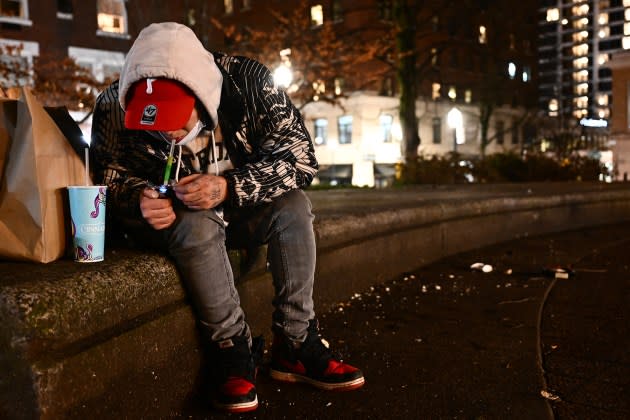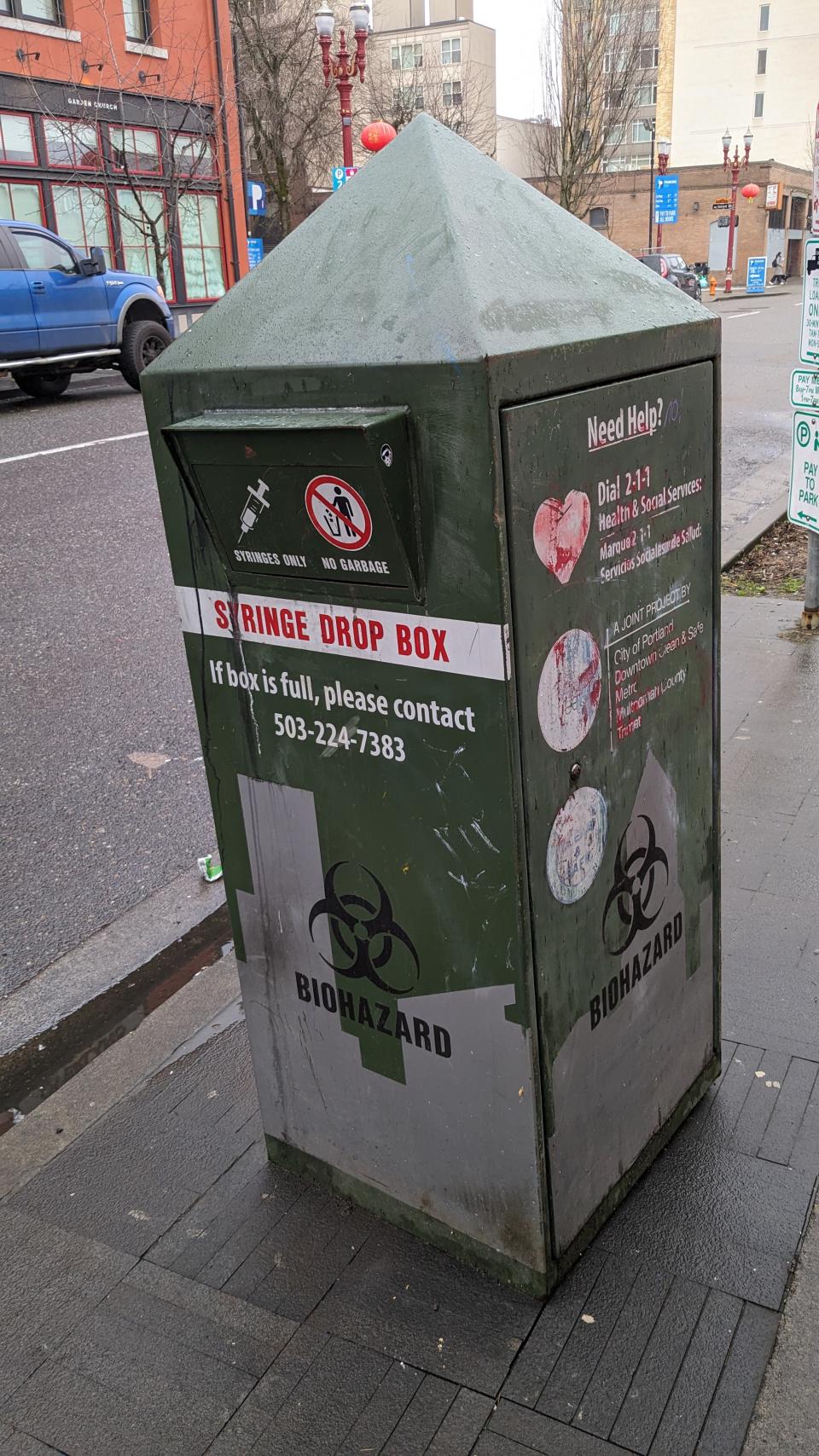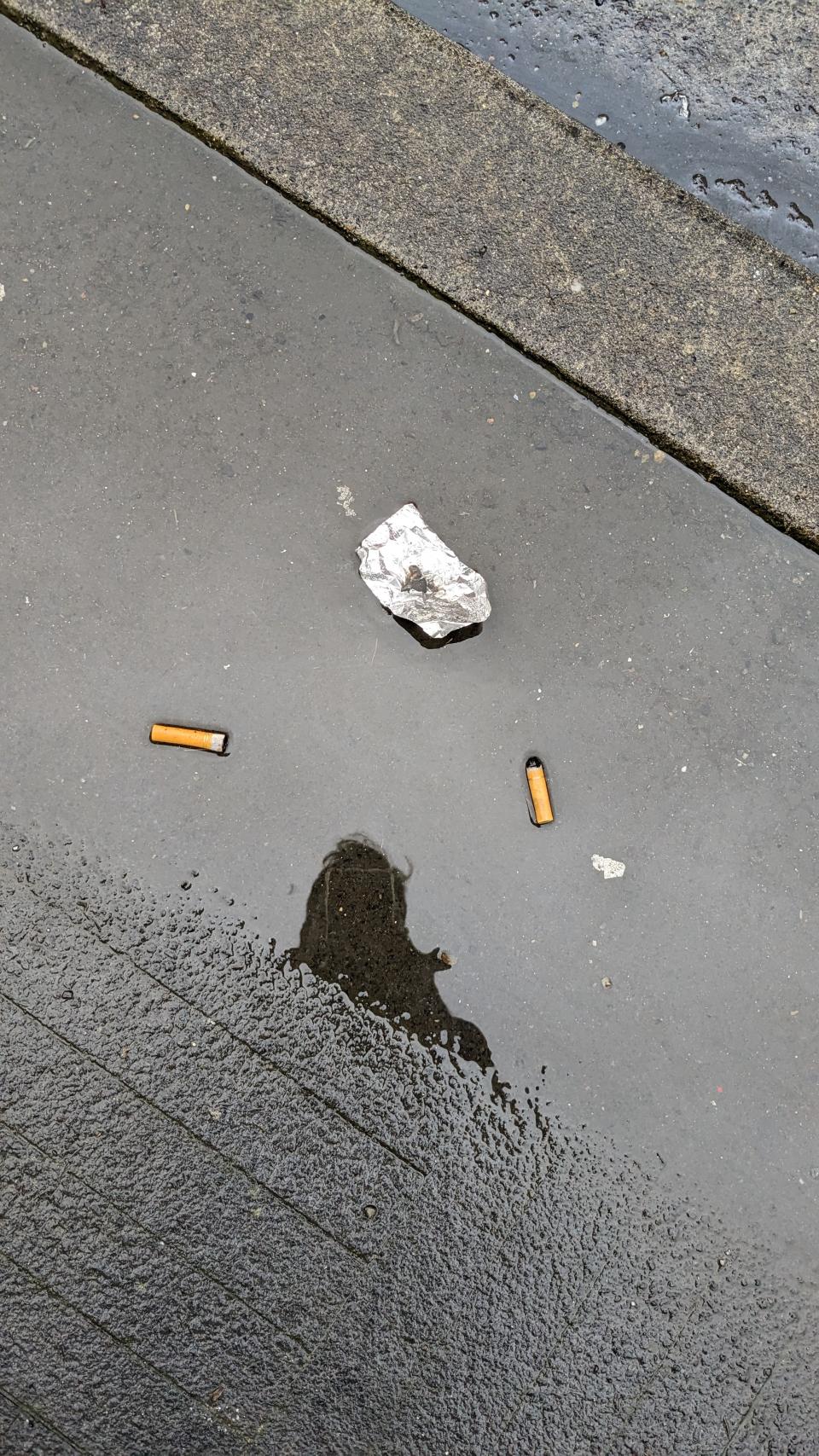Oregon Is Ready to Restart the Drug War

PORTLAND, Ore. — On a bleak block of Portland’s historic Chinatown, where dozens of people experiencing homelessness have pitched tents draped with plastic tarps, evidence of drug use litters the sidewalk. Among discarded cigarette butts lie squares of tin-foil, indented in the middle, with distinctive scorch marks, used to smoke substances like meth and fentanyl. Visible a few blocks away, a new Ritz-Carlton hotel rises, angular and gleaming, on the skyline. On the sidewalk here, the city has installed a stubby green obelisk, somewhat larger than a postal service dropbox. Provided for the disposal of used drug syringes, it is stamped with large “☣ BIOHAZARD” signs — and a local number to call “if box is full.”

In the November 2020 election, Oregon approved a historic ballot initiative that decriminalized small amounts of hard drugs, like meth, heroin, and crack. Under Measure 110, people caught with drugs were to be cited with a $100 fine, similar to a traffic ticket, that could be cleared by seeking treatment services, which would be expanded with millions in revenue from the state’s taxation of recreational marijuana sales. Winning nearly 60 percent support, the initiative promised to treat drug use and addiction as a public-health problem, not a criminal matter — adopting the logic that incarceration does little to curb the harms of substance abuse.
The Oregon experiment was unique in America, where on any given day 350,000 people — roughly the equivalent of the population of Cleveland — are locked up on drug offenses, and drug-possession arrests occur at a clip of one every 23 seconds. And the passage of Measure 110 was met with acclaim from reformers like Kassandra Frederique, executive director of the Drug Policy Alliance, who celebrated the “paradigm-shifting” victory as perhaps “the biggest blow to the war on drugs to date,” while predicting Oregon would “serve as a model” for the nation.
Instead, three years later, Measure 110 now stands as a cautionary tale about the failure to match bold policy reform with competent administration. Last week, the Oregon state legislature completed an about-face in the state’s novel approach to hard drugs — voting to recriminalize possession as a misdemeanor, with penalties of up to six months in jail. The vote was not close: The state House approved the bill 51-7, the state Senate piled on 21-8. The legislation is now awaiting the signature of Gov. Tina Kotek (D), who has vowed to sign it.
Score one for the Drug War.
The saying goes that “failure is an orphan.” But the collapse of Oregon’s bold experiment in drug decriminalization has many fathers. Some dynamics were outside of the easy control of local policymakers, including a rising tide of homelessness; the Covid-19 pandemic’s hollowing out center-city commercial life; and the flood of dirt-cheap fentanyl, leading to a scourge of street overdose deaths.
But the state bureaucracy also fumbled the implementation of Measure 110, attempting to delay and divert drug-treatment funding; failing to train law enforcement on steering drug users toward rehabilitation; and relying on a cumbersome call center that proved all-but feckless at moving people in out of the grip of addiction and into treatment.
As blocks of beleaguered downtown Portland got overrun by open-air drug markets and unhoused people smoking and shooting drugs without consequence, Measure 110 became an attractive scapegoat for the explosion of urban blight.
Correlation is not, in fact, causation. Research from Portland State University has shown Measure 110 had “no impact” on violent crime and produced at most a “slight uptick” in property crime. Overdose deaths have indeed increased in Oregon — but the trajectory was rising before Measure 110’s passage, and Oregon’s rates are “no different from similar states,” the academics write.
But politics are driven by perception. And by last spring, polling had turned decisively against the experiment, with 63 percent of voters supporting a return to criminal penalties for drug possession. This year, as deep-pocketed state business leaders threatened to launch a punitive recriminalization ballot measure, Oregon’s Democratic-led legislature snapped to action to put its imprint on reform.

The bill now on the governor’s desk would empower police to again arrest and incarcerate repeat, low-level drug users. Under the bill, counties can choose to offer a “deflection” program for arrestees who agree to enter treatment, enabling them to avoid jail time and a criminal record. The legislation also offers more than $200 million in new funding for drug courts and treatment clinics, while maintaining the funding mechanism from Measure 110, steering marijuana tax revenue into rehabilitation.
Drug reformers are furious about the squandered opportunity to model a new approach for the country. “It is Oregon leaders that didn’t work,” says Frederique of the Drug Policy Alliance. “Their chronic underfunding of affordable housing, effective addiction services, and accessible health care are to blame for the heartbreaking public suffering seen in Oregon’s streets.” Frederique insists there “is not a shred of evidence” that Measure 110 increased homelessness, crime, or overdose rates. And she sees the recriminalization bill as “a false promise” of a fix, meant to distract from political “incompetence.”
In retrospect, the key driver of Measure 110’s political demise was that it entrusted implementation of a radical drug-policy experiment to rigid state agencies and police bureaus that were not invested in — or even hostile to — its success.
Oregon was one of the few jurisdictions in the world to remove criminal penalties for hard-drug possession. Measure 110 was modeled after a similar experiment in Portugal, where the 2001 decriminalization of hard drugs — matched with wraparound investment in addiction treatment and public health — yielded impressive results: The numbers of people with heroin addictions plummeted, HIV infections did too, and taxpayers saved money as Portugal experienced the lowest drug-related death rates in Western Europe.
But in contrast to a Western European democracy with universal health care, Oregon does not have a highly functional public sector. The state has a poorly paid, part-time legislature, and the state government often fails at major lifts. Oregon infamously spent $303 million on an Obamacare website that was so dysfunctional the state had to scrap it entirely, and join the federal exchange.
When Measure 110 passed in 2020, the state’s addiction-care services were already severely overburdened. According to the secretary of state’s office, Oregon had the nation’s second-highest rate of substance abuse disorders, but it ranked 50th in treatment access. The deadly scourge of cheap fentanyl, meanwhile, was just beginning to hit the state, full force.
The state’s former governor, Kate Brown, recently told reporters that Measure 110 demanded bold change of a state that was “probably one of the least prepared to be successful.” Brown, a Democrat who left the job with the worst approval rating in the country, has also been frank that her policy priorities were elsewhere — including attending to Covid vaccine rollouts, school reopenings, wildfire response, and the unrest in the streets following the murder of George Floyd.
The Oregon Health Authority — statutorily responsible for “all necessary support to ensure the implementation” of Measure 110 — also showed little energy in ensuring a successful launch. As detailed in a joint investigation by Oregon Public Broadcasting and ProPublica, the agency never developed guidance for local police bureaus about the expanded treatment resources available for people cited for drug possession. Likewise, the Oregon Judicial Department made no effort to create a new drug ticket that would include information about how to secure treatment, meaning cops were left using a general purpose citation like they would for traffic stops.
Naively, the drafters of Measure 110 anticipated a productive partnership from cops, whom they expected would educate people caught with drugs about the new systems being set up to help them overcome addiction. The legislature did not devote any new funding for training, and cops themselves were only given an update about differentiating between the drug-quantity thresholds that merited a citation, rather than a criminal arrest.
As revealed in interviews by local academics, Oregon police were accustomed to a drug-war model of law enforcement in which possession arrests created a probable cause for search, which could produce evidence of greater crimes. Low-level users were routinely leveraged for information on dealers, giving cops intel they could work up the chain to target bigger fish.
Measure 110 short circuited that style of policing. And cops told researchers they not only preferred that more intrusive model, they had little patience for issuing possession citations, which carried penalties less stiff than traffic violations, but still required time-consuming evidence booking and paperwork. Rather than step up as ambassadors for moving people who abuse drugs into treatment, many cops chose not to bother even issuing citations, turning a blind eye to even brazen open-air drug use.
According to state audits, police had previously made about 1,200 arrests a month for drug possession; but they would issue only about 200 possession citations a month after the passage of Measure 110. Meanwhile, the hotline the state set up to field calls from people seeking diversion into treatment received only 119 calls in the first 15 months, and was averaging only 20 calls a month when last measured in mid-2023.
The legislature did not offer productive tweaks to the program. In fact, the body voted to eliminate consequences for people who racked up $100 citations for possession — effectively removing the one stick that was supposed to prod people who use drugs toward the carrot of treatment.
The state’s new governor, Kotek, campaigned as a defender of Measure 110, and promised to speed up treatment funding and other implementation resources. But that energy proved too little too late to bring the reality of Measure 110 implementation into line with public expectation. Kotek had earlier indicated a willingness to consider recriminalization, and said March 8 that she intends to sign the legislature’s new bill, insisting she will focus on “implementation” to “balance treatment for individuals struggling with addiction and accountability.”
Even as Measure 110 approaches its downfall, the initiatives’ defenders still tout the good that it has done, and the harms it avoided, chiefly by steering $300 million into treatment and keeping thousands of people out of the criminal justice system.
While the recriminalization bill is moderate by most standards, its impacts are projected by the state itself to fall disparately on minorities. “It is an unacceptable ‘compromise’ when we know that there will be disparate impacts to Oregonians of color,” argues Jennifer Parrish Taylor, who directs public policy for the Urban League of Portland. “We know it is a system that has bias built into it, and I fear that we will be back next year, hearing those stories of harm, figuring out how to make our communities whole.”
More from Rolling Stone
Supreme Court to Review Case on Homeless Residents Sleeping in Public
See Jelly Roll Address Lawmakers and Lobby for Anti-Fentanyl Act at Senate Hearing
Fentanyl-Laced Letters Sent to Election Offices in Multiple States
Best of Rolling Stone

